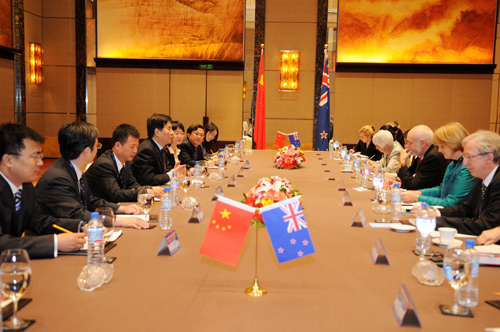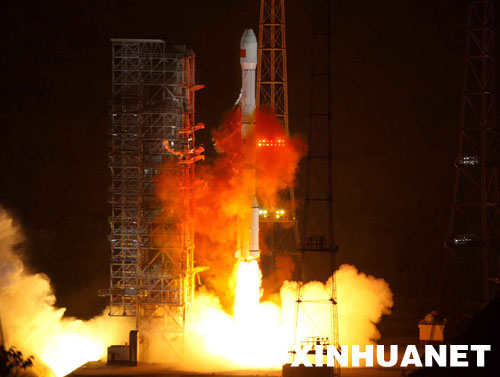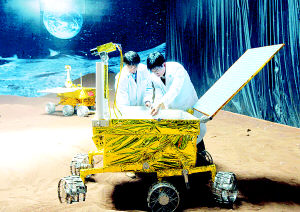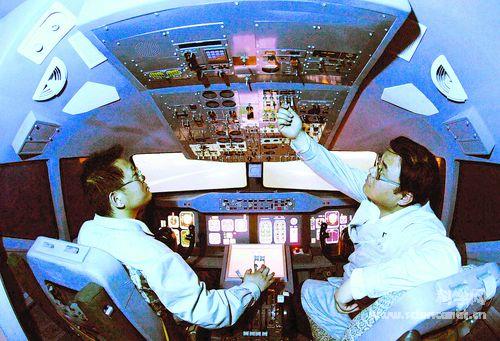|
CHINA SCIENCE AND TECHNOLOGY
NEWSLETTER
The Ministry of Science and Technology
People's Republic of China
|
|
|
N0.509 |
April 30,2008 |
|
|
|
|
|
|
|
|
IN THIS ISSUE
|
|
* MOST Supports Energy Efficiency and Emission Reduction
* More Patent and Trademark Applications
* China and New Zealand Met to Market S&T Findings
* Chinese and US Scientists Map Papaya Genes
* China Launched Its First Relay Satellite
* China Working on Its Moon Rover
|
MOST Supports Energy Efficiency and Emission Reduction
As of today, Chinese Ministry of Science and Technology (MOST) has secured some RMB 7 billion to support energy efficiency, emission reduction, and climate change related activities.
In the area of energy efficiency and emission reduction, numerous green technologies have found applications and diffusions in mining and oil-gas drilling activities, which has greatly enhanced the sustainable development capacity of resources tapping industries. Demonstrations and applications of clean production technologies in heavy polluters, including salt mining, leather making, and alcohol brewing, has created a technical ground for treating major industrial wastewater in a cyclic manner. Solid wastes treatment and associated comprehensive utilization has also achieved noticeable results, which facilitates future industrial applications on a large scale. Lake pollution control and bioremediation, improvement of urban water environment and drinking water safety, and urban sewage treatment saw laudable progresses in developing the needed technologies, with an established proprietary innovation framework for water pollution control. The raised technology development level for atmospheric pollution control has spurred up applications of novel technologies in the area. A raised market share of domestic made environmental pollution monitoring equipment and technologies has ensured hardware supply for pollutants emission reduction in the country. Efforts have also been made to demonstrate and diffuse diverse novel energy technologies, including coalbed gas and biomass energy, created a ground for the large scale development and utilization in the future.
To respond to climate change, China has established a number of baseline observation stations, and collected scientific data on CH4 emissions in the paddy fields. China has a paleoclimate study that has kept abreast with the similar studies in the advanced countries, using yellow soil, stalagmites, ice core, lake core, and historical literatures. Chinese scientists have mapped out temperature variation curves reflecting China’s climate change in the last one hundred years, with proprietary global and regional climate models. They also looked into the relationship between Asian monsoon activities/variations and droughts and floods in China, and established future climate change scenarios for China. To study the impacts of climate change and associated response strategies, Chinese scientists have come up with an important conclusion indicating that the croplands in China is a weak sink of carbon. The following are the other findings or results derived from the efforts: a random daily weather model, a proprietary model for assessing regional impacts on agriculture, a database for studying the impacts of climate change, a software program containing major policies and action plans for response to global climate change, cost-benefit analysis of most vulnerable regions to the sea level rise, and a climate change risk study methodology of international compatibility. In addition, MOST has financed R&D efforts in the area of greenhouse gas emission control and reduction, analysis of socioeconomic impacts of climate change, formulation of alleviation strategies, and infrastructure capacity building.
More Patent and Trademark Applications
China State Intellectual Property Office recently announced that as of the end of 2007 China has handled more than 4 million patent applications and over 5.6 million trademark applications from both home and abroad, with registered trademarks exceeding 3 million in number. It took one year and six month for China’s patent applications to go from third million to fourth million. In 2007, State Intellectual Property Office handled 694,000 patent applications, with a growth of 21.2%, of which invention, utility, and design have reached 245,000, 181,000, and 268,000 respectively in number, with a growth of 16.5%, 12.4%, and 33.0%. Meanwhile, Chinese nationals have filed 5,401 international patent applications, with a 41.2% growth compared with the same period, ranking in 7th place after the United States, Japan, Germany, France, the Republic of Korea, and the UK, or one place advanced compared with the end of 2006.
In 2007, China has for the first time recorded an annual trademark application exceeding 400,000 in number. China State Administration for Industry and Commerce has handled 708, 000 trademark applications, of which 605,000 were domestic applications, and 103,000 foreign applications. The Administration has granted 263,000 trademarks in the year. At the same time, authorities concerned have acknowledged 197 trademarks as famous trademark.
Protecting China’s Largest Freshwater Lake
Chinese Ministry of Science and Technology and Jiangxi Province jointly launched on April 27, 2008 a project to study the ecological protection and resources utilization of the Panyang Lake, the largest freshwater lake in the country. With a budget worth RMB 52 million, the study will cover 5 aspects concerning the lake’s comprehensive ecosystem management and sustainable development, using diverse technical means, including RS, DCS, GPS, GIS, computer network, multimedia, and modern telecommunication. The project will eventually produce a detailed biological database for the lake, and an array of scientific evidences for protecting the lake, and for the sustainable development.
|
INTERNATIONAL COOPERATION |
China and New Zealand Met to Market S&T Findings


Officials from the Chinese Ministry of Science and Technology and New Zealand Ministry of Research, Science and Technology met on April 17, 2008, to enhance the marketing aspects of S&T findings. LIU Yanhua, Chinese Vice-Minister of Science and Technology, and Pete Hodgson, the visiting Minister for Research, Science and Technology, made their key note speeches at the opening meeting. LIU introduced China’s proprietary innovation strategies, and discussed both opportunities and challenges that two nations have shared in the development of science and technology. He said S&T cooperation between the two countries shall be more on mechanism innovations, allowing the marketplace to play a role. He added that industry shall be encouraged to become a key player of S&T cooperation between the two countries, rendering their due contributions to the economic, social, and S&T development. Pete Hodgson said: ”it is New Zealand's strong commitment to build a scientific partnership with China, after the signing last week of a historic free trade agreement”. He believed that both China and New Zealand share a broad perspective for cooperation in the fields of sustainable agriculture, climate change, polar study, and functional foods, and the collaboration is important to the sustained economic growth and development of both countries.
At the meeting, some 200 government officials, researchers, and entrepreneurs from China and New Zealand discussed a string of collaborating issues on energy, environment, food, health, biotechnology, and agriculture.
Chinese and US Scientists Map Papaya Genes
Chinese and US scientists have jointly mapped up the full genome of a genetically modified cash crop, the first of its kind in the world. The finding, published in the April 24, 2008 issues of the journal Nature, was derived from a 10-million US dollar joint research project undertaken by Nankai University, Tianjin Functional Genome and Biochip Center, and the University of Hawaii, with the participation of some 30 research institutes and universities in China and the United States. Tianjin Functional Genome and Biochip Center has created four major platforms for the purpose, involving functional genomics, genomics, bioinformatics, and proteomics. The platforms have produced a range of proprietary innovations of an internationally leading level in the area of diseases causing microbes testing, genomics, and functional genomics.
Bionic Solar Cells
A study team, headed by Prof. SUN Zhuo at East China Normal University, has reconstructed ‘chloroplast’ using nanomaterials in a lab environment, which makes low-cost photo voltaic generation possible. SUN demonstrated the sandwich structure of the novel solar cells, featured with a nanolayer in the middle. The nanolayer allows dye to be a light capture, and CAS a photo-volt converter. Researchers made nano fluorescent powders an enhancer, facilitating dye to absorb solar light at different wavelengths. Photo-volt conversion can be repeatedly enhanced, along with an increasingly improved ‘recipe”. Based on repeated experiments for three years, researchers have finally rolled out the bionic dye sensitive solar cells, with a structure similar to chloroplast. The novel cells have registered a photo-volt conversion rate exceeding 10%, approaching the world record level of 11%.
CSTAR Sent Back Image Data
CSTAR, Chinese made telescopes installed for the first time on the Amery Ice Shelf, have been working smoothly to observe the Antarctic sky, and feeding to the ground control with continuous flows of image data. The development indicates that Chinese scientists have found solutions to a string of problems that had to be solved before making four CSTAR telescopes operational in the extreme working environment of the Antarctic, including large view field tuning, lens icing, and long distance shipping.
According to a briefing, the telescopes had been tested to watch stars of a limiting visual magnitude of 13 at the Xinglong Observatory, a national astronomical observation station, before being shipped to the Antarctic. The unique atmospheric condition of the Amery Ice Shelf in the Antarctic allows an observation of the darkest stars at a limiting visual magnitude of 16.5.
China Launched Its First Relay Satellite

At 23:35 April 25, 2008, China blasted off a relay satellite from the Xi’chang Satellite Launch Center. 25 minutes after the launch, the ground control received data indicating that the satellite has entered the preset geostationary transfer orbit. Tianlian 01, the relay satellite, will serve as a telecommunication hub between the Shenzhou 7 capsule, a spacecraft to be launched late this year, and the ground control, allowing a greatly enhanced coverage from 12% to 60%. The satellite, launched for the first time aboard a novel 3-stage liquid fuel launch vehicle named CZIII-C, is designed with two boosters, a total length of 55-m, and a take-off weight of 343 tons.
China Working on Its Moon Rover

Prototype
Shanghai Municipal S&T Committee announced on April 23, 2008 that scientists in the city have landed substantive progresses in addressing two key technical issues relating to the walking system and general design of the Moon Rover, which makes the moon rover cruising on the lunar surface possible. Scientists have so far developed a range of prototype rovers in the context of concept, principle, and engineering, validated the feasibility of the technical plan, and mastered the techniques to make the rover. They have also found solutions to the key technologies that have to be addressed before becoming an official developer of the moon rover, along with a ground simulation plan.
A 6-free-degree Flying Simulator

Not long ago, a 6-free-degree flying simulator, developed by China Civil Aviation University, has been put into operation for training pilots. The new system is equipped with 16 novel key technologies, including simulated flying, movement control, and landscape viewing.
Land Based Space Measuring Expanded
A new space measuring station was recently put into operation in Sanya of Hainan. The new station, joining the other twos in Kashi and Jiamusi, has completed the deployment of a land based space measuring network in a triangle shape, a major strategic readjustment made to the existing space measuring network in the country. As a new endeavor to upgrade China’s space measuring network, the development has effectively wiped out the blind spots that could not be covered in the past. The new station, together with other 10 stations affiliated to the satellite ground control in Xi’an, will work for the real time control and long term management of spacecraft in orbit, providing an enhanced support for the rapid development of China’s space industry.
Large Pulsed High Magnetic Unit
Large experimental unit for pulsed high magnetic field, a key national S&T infrastructure project, was kicked off on April 25, 2008 at Huazhong University of Science and Technology. The unit will add one more facility to the current arrays created by the United States, France, and Germany for studying high magnetic fields. With an investment worth RMB 120 million, the unit will allow scientists to produce more original innovations. In a 5-year construction period, the project will build 11 short pulse magnets, long pulse magnets, and short-long pulse magnets, and establish seven scientific experiment systems and associated support facilities for electrical transport, magnetic properties, magneto-optical properties, press effects, and extreme low temperatures.
Home Made Composite Shield Machine
Under the financing of National 863 Program, Chinese engineers have rolled out on April 25, 2008 the first composite shield machine in the country. The machine, 6.3m across with a maximum digging speed of 8cm per minute, will be firstly employed to build urban tube tunnels. The new machine has a greatly enhanced geological adaptability to winding, direction turning, and rolling error correction. It is also designed to cope with diverse emergencies, including handling the stuck operation, safety protection, and water flushing.
Comments or inquiries on editorial matters or Newsletter content should be directed to:
Mr. XU Chaoqian, Department of International Cooperation, MOST 15B, Fuxing Road, Beijing 100862, PR China Tel: (8610)58881360 Fax: (8610) 58881364
http://www.most.gov.cn |

